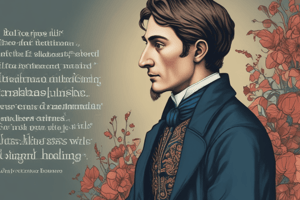Podcast
Questions and Answers
What type of sonnet does Hopkins use to great effect in his poetry?
What type of sonnet does Hopkins use to great effect in his poetry?
The Petrarchan Sonnet
What does Hopkins try to capture in his descriptions through his use of language?
What does Hopkins try to capture in his descriptions through his use of language?
Instress and inscape
What type of rhythm does Hopkins use to create a natural and speech-like effect in his poetry?
What type of rhythm does Hopkins use to create a natural and speech-like effect in his poetry?
Sprung rhythm
What is a key feature of Hopkins' vocabulary and syntax?
What is a key feature of Hopkins' vocabulary and syntax?
Study Notes
Gerard Manley Hopkins: Life and Background
- Born on July 28, 1844, in Essex, as the eldest of nine children
- Excelled academically, studying Classics at Oxford University
- Converted to Catholicism at 22 and joined the Jesuit Order in 1868, driven by devotion to God
- Spent time in Wales and Northern Britain, where he found happiness in nature
- Suffered from ill health, low moods, and depression throughout his life
- Became a Professor of Latin and Greek in University College Dublin in 1884
- Wrote his 'Terrible Sonnets' during this difficult period in Dublin
- Died of typhoid fever in 1889
Key Themes in Hopkins' Work
- Love of God and God's creations
- Beauty of Nature
- Mankind's destructive power
- Suffering
- Depression and Despair
Hopkins' Writing Style
- Uses striking imagery and figurative language (similes, metaphors, personification)
- Employs challenging vocabulary and syntax
- Often uses neologisms, compound words, and ellipsis
- Utilizes Petrarchan Sonnets with set rhyme-schemes
- Tries to capture 'instress' and 'inscape' through descriptions
- Employs sprung rhythm to create a natural, speech-like tone
Studying That Suits You
Use AI to generate personalized quizzes and flashcards to suit your learning preferences.
Description
Learn about the life of Gerard Manley Hopkins, a renowned poet, from his birth and education to his conversion to Catholicism and decision to become a priest. Explore his early years and literary influences.


